
CARP --- THE UNKNOWN GAMEFISH

CARP --- THE UNKNOWN GAMEFISH
Lake Mead
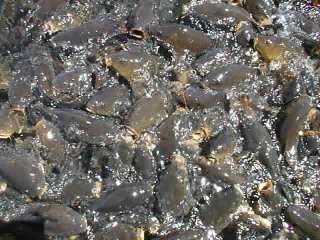
Normally when gravel is extracted from lakes, the method used creates long strips of gravel which are like banked seating at a football stadium . These are called gravel bars . These are excellent places to fish as not only do the fish feel safe but food tends to collect at the bottom of these bars. The fish tend to use these bars to travel around a lake in the same way we follow a motorway (interstate) . Most of the time these bar`s are invisible (being underwater) By finding the change in depth you are well on your way to finding a HOT SPOT all of your own.
With
experience you tell what sort of bottom you are fishing in. How is that
important you might ask. Well carp just like humans have favorite places
to eat. Sometimes the softer (silty) bottoms contain all sorts of goodies
for the fish to eat . The technique of feeling along the bottom with rod
and line is something where practice is needed. You have to use a heavy
lead (sinker) of at least 2oz so keeping a tight line between rod and lead.
You cast out the lead and pull it along
the bottom with the rod at right angles to the water. You can "feel" the
lead through the rod . When you are over gravel , the tip will ping and
stutter as if you are dragging it over a jagged rock (which you are) You
will find the lead has lots of marks in it , this is a sure sign of a gravel
bottom. Where as with a soft bottom the lead would have sunk in so takes
a bit of effort to get it out but you can feel its like pulling the lead
through sludge (which it is) With a sandy type bottom you will find it
will be harder than the silty bottom so the lead wont sink in so far .
You will find it a smooth steady pull with a consistent resistance. When
fishing waters with lots of weed in them it pays to try and find clear
areas
near
the weed as there is a good chance(if they are the same depth as the weed)
that they are kept clear by moving and feeding fish . I had one of my best
catches ever by finding a small clear area next to lots of weed . Knowing
the bottom also lets you plan what size of hook lengths to use. I wouldn't
feel very confident fishing short hook lengths in a deep soft bottom like
silt.
The trick is finding large fish that can be caught readily. Of course, you don't have to start out with 20 pound fish. An 8 pound carp puts up a good fight, especially on light line, and is probably the largest fish caught by the majority of anglers.
Chumming
(the introduction of food to the water for the sake of attracting fish)
is not legal in all states. So check your regulations before you start
doing it.
There
is an art to chumming. If you over feed an area, the fish will shut down
and
you
will not catch them. Too little food and they will move on to a better
place.
Fortunately,
carp are eating machines and they travel in packs, so it is hard to
overfeed
them You can chum with anything, but the best way to start is with corn.
Canned sweetcorn is the most available.
After
a while you will learn what to chum with, where to chum and how much.
You
can fish with the same bait you use in your chumming or you can use
something
different in the hope of attracting a fish. The neat thing about fishing
is that you constantly have to try to outsmart them.
A common
mistake anglers around the world make is to use the wrong hook. In
North
America this means using a treble hook to fish for carp. While trebles
have
some
advantages (I'm sure), the disadvantages are numerous, if subtle. They
are
cruel
to the fish as foul hooking is common causing scarring and other injuries.
More
important is the fact that treble hooks are very large and will spook wary
fish. A size 6 treble is twice the diameter of a size 6 single making it
the same as a 3/0 single hook. Treble hooks have narrow gapes and their
geometry is such that a good hookup is not always assured. Most trebles
are of dubious quality and they have
a tendency to snag on weeds, etc.
Single
hooks can be poorly made, but if you buy quality brands (e.g. Owner SSG,
Gamakatsu
Octopus, Eagle Claw L84, Partridge, etc.) you won't regret it because
they
are very sharp and will not break. The best size range is from 10 to 2,
depending
on what you are trying to achieve with your rigs. Larger hooks only
make
it harder to catch the fish (as do smaller hooks because they pull out
easily)
and
can scare off big fish.
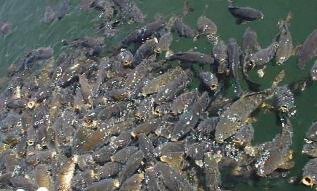
Baits
Carp
will eat anything. I have reports of carp eating live shad on trot lines,
crawfish, hot dogs, worms, corn, maggots, spam and breakfast food.
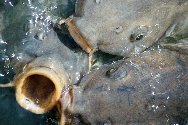 |
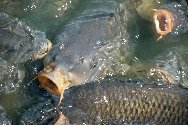 |
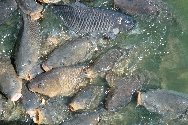 |
| Links
to other
Carp Sites |
| Books
on
Carp Fishing |
Lots and Lots of Free Stuff |
|